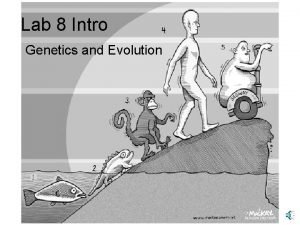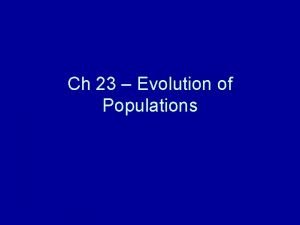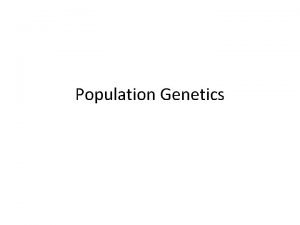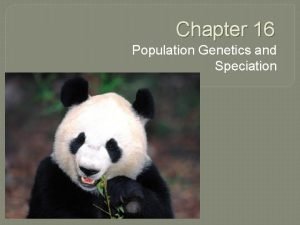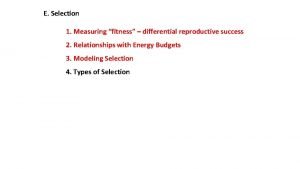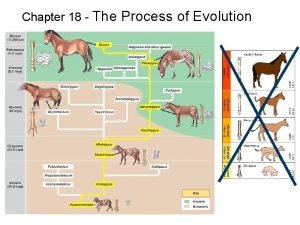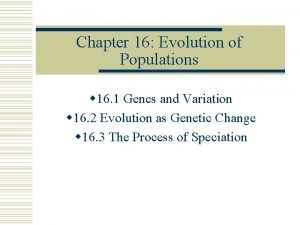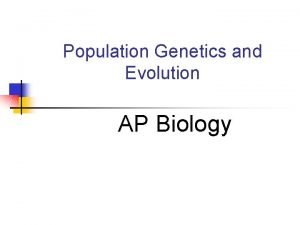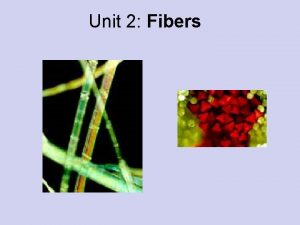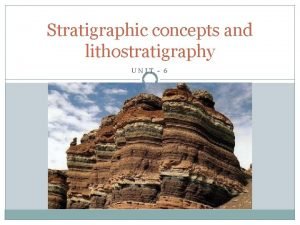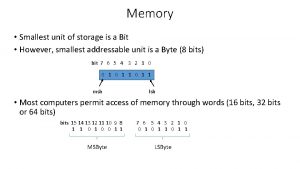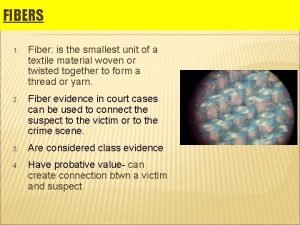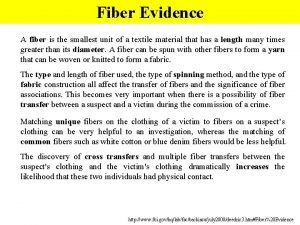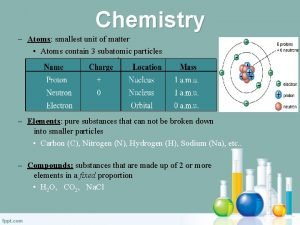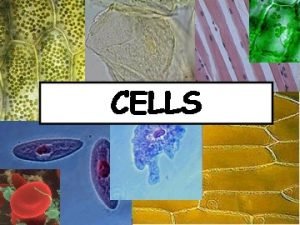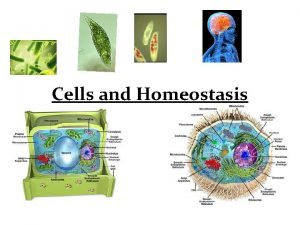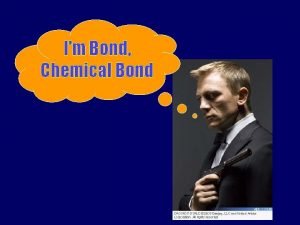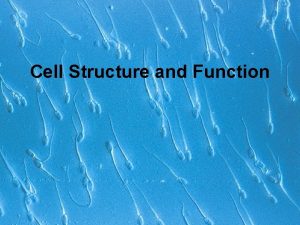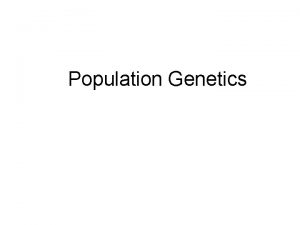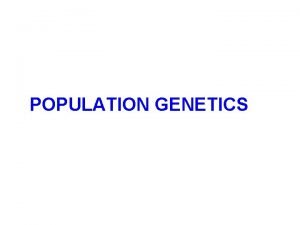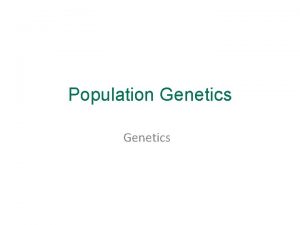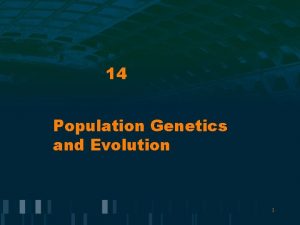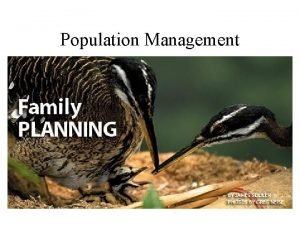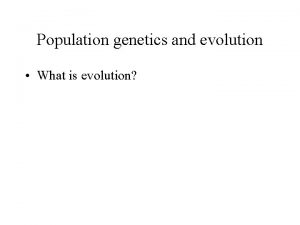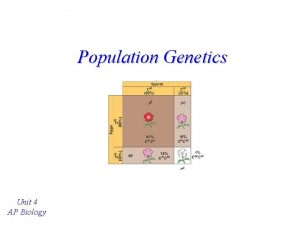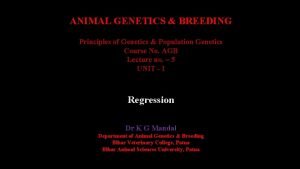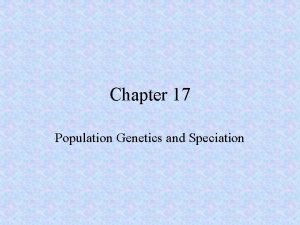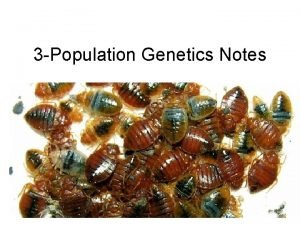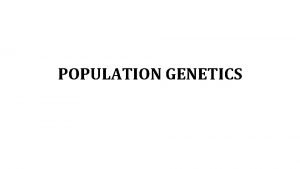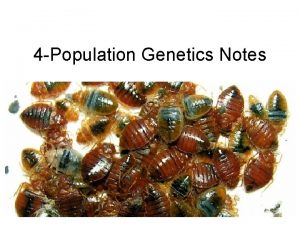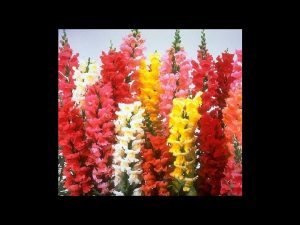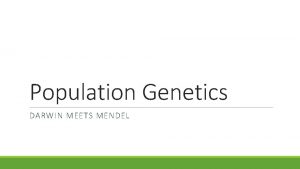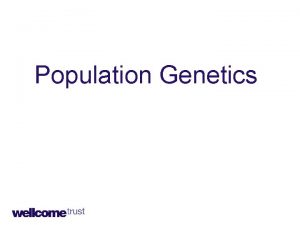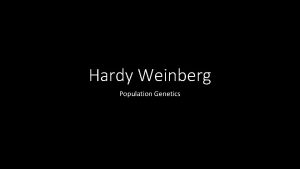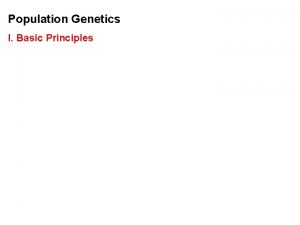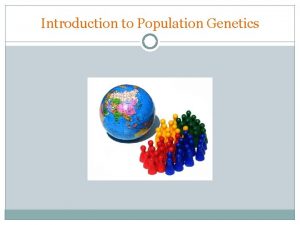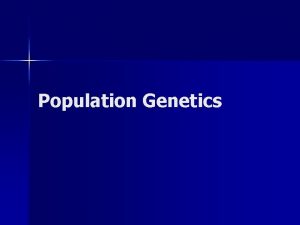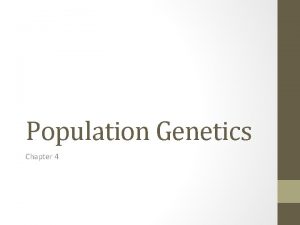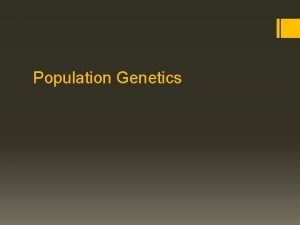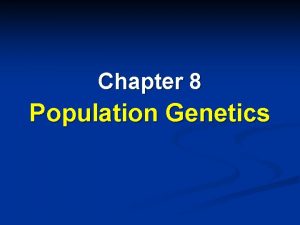POPULATION GENETICS OVERVIEW THE SMALLEST UNIT OF EVOLUTION




























- Slides: 28

POPULATION GENETICS

OVERVIEW: THE SMALLEST UNIT OF EVOLUTION � Natural � On � only selection acts on individuals phenotypes populations evolve � Genetic variations contribute to evolution � Microevolution � change in the genetic makeup of a population from generation to generation

THE MODERN SYNTHESIS � Population � study genetics of how populations change genetically over time � integrates Mendelian genetics with the Darwinian theory of evolution by natural selection

GENE POOLS AND ALLELE FREQUENCIES • gene pool is the total aggregate of genes in a population at any one time � gene pool consists of all gene loci in all individuals of the population

MAP AREA CANADA ALASKA LE 23 -3 Beaufort Sea T ES S HW RIE RT TO NO RRI TE Porcupine herd range Fairbanks ALASKA YUKON Fortymile herd range Whitehorse

THE HARDY-WEINBERG THEOREM � describes a population that is not evolving � frequencies of alleles and genotypes in a population’s gene pool remain constant from generation to generation � provided that only Mendelian segregation and recombination of alleles are at work � Mendelian population inheritance preserves genetic variation in a

LE 23 -4 Generation 1 X CRCR genotype Generation 2 Plants mate CW CW genotype All CRCW (all pink flowers) 50% CW gametes 50% CR gametes come together at random Generation 3 25% CRCR 50% CRCW 50% CR gametes 25% CWCW 50% CW gametes come together at random Generation 4 25% CRCR 50% CRCW 25% CWCW Alleles segregate, and subsequent generations also have three types of flowers in the same proportions

� If p and q represent the relative frequencies of the only two possible alleles in a population at a particular locus, then � p 2 + 2 pq + q 2 = 1 � p 2 and q 2 represent the frequencies of the homozygous genotypes � 2 pq represents the frequency of the heterozygous genotype �p +q=1 �p represents the frequency of one allele (dominant) � q represents the frequency of the other allele (recessive)

� The five conditions for non-evolving populations are rarely met in nature: � Extremely large population size � No gene flow � No mutations � Random mating � No natural selection

POPULATION GENETICS AND HUMAN HEALTH � We can use the Hardy-Weinberg equation to estimate the percentage of the human population carrying the allele for an inherited disease

VARIATION THAT MAKES EVOLUTION POSSIBLE � Mutation changes in the nucleotide sequence of DNA � cause new genes and alleles to arise � point mutation is a change in one base in a gene � � usually harmless but may have significant impact on phenotype Chromosomal mutations that delete, disrupt, or rearrange many loci are typically harmful � Gene duplication is nearly always harmful � Mutation rates are low in animals and plants � � one � � mutation in every 100, 000 genes per generation Mutations are more rapid in microorganisms sexual recombination � far more important than mutation in producing the genetic differences that make adaptation possible

Deletion Duplication Inversion Translocation

A POPULATION’S GENETIC COMPOSITION � Three major factors alter allele frequencies and bring about most evolutionary change: � Natural selection � Genetic drift � Gene flow

LE 23 -7 CWCW CRCR CRCW Only 5 of 10 plants leave offspring CRCR CWCW CRCW CWCW CRCR CRCW CRCR CRCW Generation 1 p (frequency of CR) = 0. 7 q (frequency of CW) = 0. 3 CWCW CRCR Only 2 of 10 plants leave offspring CRCR CRCR CRCW Generation 2 p = 0. 5 q = 0. 5 CRCR Generation 3 p = 1. 0 q = 0. 0

LE 23 -8 Original population Bottlenecking event Surviving population

GENETIC VARIATION � Genetic variation occurs in individuals in populations of all species � It is not always heritable

LE 23 -9 Map butterflies that emerge in spring: orange and brown Map butterflies that emerge in late summer: black and white

POLYMORPHISM � Phenotypic polymorphism �a population in which two or more distinct morphs for a character are represented in high enough frequencies to be readily noticeable � Most species exhibit geographic variation differences between gene pools of separate populations or population subgroups

LE 23 -11 Heights of yarrow plants grown in common garden Mean height (cm) 100 50 Altitude (m) 0 3, 000 2, 000 1, 000 Sierra Nevada Range 0 Seed collection sites Great Basin Plateau

SELECTION � Selection favors certain genotypes by acting on the phenotypes of certain organisms � Three modes of selection: � Directional � Disruptive � Stabilizing

� Directional � favors selection individuals at one end of the phenotypic range � Disruptive selection � favors individuals at both extremes of the phenotypic range � Stabilizing � favors selection intermediate variants and acts against extreme phenotypes

Frequency of individuals LE 23 -12 Original population Evolved population Directional selection Original population Phenotypes (fur color) Disruptive selection Stabilizing selection

THE PRESERVATION OF GENETIC VARIATION � Diploidy � maintains genetic variation in the form of hidden recessive alleles � Balancing selection � occurs when natural selection maintains stable frequencies of two or more phenotypic forms in a population � leads to a state called balanced polymorphism � Heterozygote Advantage � maintains two or more alleles at that locus � Ex. sickle-cell allele � causes mutations in hemoglobin � also confers malaria resistance

LE 23 -13 Frequencies of the sickle-cell allele 0– 2. 5% 2. 5– 5. 0% 5. 0– 7. 5% Distribution of malaria caused by Plasmodium falciparum (a protozoan) 7. 5– 10. 0% 10. 0– 12. 5% >12. 5%

� In frequency-dependent selection � fitness of any morph declines if it becomes too common in the population

LE 23 -14 On pecking a moth image the blue jay receives a food reward. If the bird does not detect a moth on either screen, it pecks the green circle to continue a new set of images (a new feeding opportunity). Parental population sample 0. 6 Phenotypic variation Experimental group sample 0. 5 0. 4 Frequencyindependent control 0. 3 0. 2 0 Plain background Patterned background 20 40 60 Generation number 80 100

SEXUAL SELECTION � Sexual selection � natural selection for mating success � can result in sexual dimorphism � marked differences between the sexes in secondary sexual characteristics � Intrasexual selection � competition among individuals of one sex for mates of the opposite sex � Intersexual selection � occurs when individuals of one sex (usually females) are choosy in selecting their mates from individuals of the other sex � Selection may depend on the showiness of the male’s appearance

 Genetics
Genetics Smallest unit of evolution
Smallest unit of evolution Population genetics
Population genetics Population genetics and speciation worksheet answer key
Population genetics and speciation worksheet answer key Modern synthesis
Modern synthesis The far side comics
The far side comics Population genetics
Population genetics Genetics
Genetics Population ecology section 1 population dynamics
Population ecology section 1 population dynamics Section 1 population dynamics
Section 1 population dynamics Population ecology section 1 population dynamics
Population ecology section 1 population dynamics Chapter 4 population ecology section 1 population dynamics
Chapter 4 population ecology section 1 population dynamics What is the smallest unit of cotton fabric
What is the smallest unit of cotton fabric Laterial continuity
Laterial continuity What is the smallest unit of memory
What is the smallest unit of memory The smallest unit of nylon
The smallest unit of nylon What is the smallest unit of a textile
What is the smallest unit of a textile Are atoms the smallest unit of matter
Are atoms the smallest unit of matter The smallest unit of life is _______.
The smallest unit of life is _______. Smallest living unit
Smallest living unit Cells are the smallest unit of life
Cells are the smallest unit of life Smallest living unit
Smallest living unit The smallest unit of an element
The smallest unit of an element What is the smallest addressable unit of memory?
What is the smallest addressable unit of memory? Smallest unit of metallic bond
Smallest unit of metallic bond Smallest unit of synthetic fibre
Smallest unit of synthetic fibre What is the smallest living unit in the body
What is the smallest living unit in the body What is the smallest living unit
What is the smallest living unit What is the smallest unit of a metallic bond
What is the smallest unit of a metallic bond
